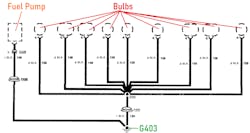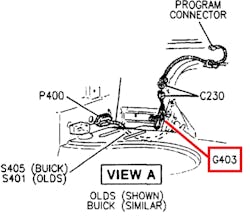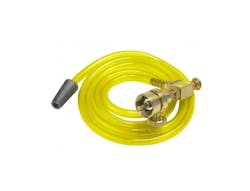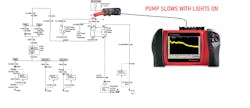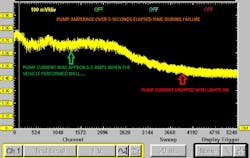Content brought to you by Motor Age. To subscribe, click here.
What You Will Learn:
• Keeping a calendar of the daily weather can aid in your diagnostic approach.
• A thorough customer interrogation prior to approaching the vehicle can bring you success, when many others have failed to find the root-cause fault.
• Bing successful means having a game plan and sticking to it.
With the wide range of vehicle years, makes, and models prevalent in today’s workshops, diagnostics is difficult enough. Interrogating the customer before approaching the vehicle can save hours of time and sometimes thousands of dollars.
With every system and component we will face as automotive diagnosticians, physics is one thing they all have in common. With Newton’s third law always dangling overhead, for every action lives an equal and opposite reaction. That statement holds significance because as automotive diagnosticians, we always chase symptoms or customer complaints. But it’s not the symptoms we must be seeking. It’s the root cause of those symptoms that are the true culprits.
Back to my roots
As a young and inexperienced technician, although fascinated by diagnostics, I struggled to gain a sense of direction early in the process. Even simple tasks like replicating the customer’s concern proved to be no easy feat. Years later, I have grown to learn that the cause of my aches and pains was because I wasn’t asking the correct questions.
My mentor, Jim Morton, owned a series of repair shops in Philadelphia (Figure 1). On average, he and his team tackled 28 of the ugliest “eat-your-lunch” myriad of electrical and driveability faults you could’ve imagined (I heard the stories a thousand times, Ha!).
Keep in mind that this was the early to mid-’90s. If you think troubleshooting today’s vehicles is difficult, try doing it back then with very little available scan tool data. To tackle an average of 28 problem vehicles a day, do you think he had a game plan? You had better believe he did. In fact, he was labeled as “Sherlock Holmes with a wrench” by renowned writer Joe Woods (of Motor Age magazine and many others). Why? It was because of his questioning methods.
The interrogation process
A common occurrence (even today) is that the person delivering the vehicle to the shop for diagnosis is not necessarily the person experiencing the fault/has the complaint. Most often this is due to a convenience factor. Mr. Customer experiences the fault but he must be at work early, so Mrs. Customer brings the vehicle to the shop because she has a paid day off. The issue with this is that complaint descriptions are either lost in translation or not discussed at all.
Jim has a rule at his shops. He will gladly tackle any electrical or driveability fault. However, the person experiencing the fault must agree to a 15-minute interview in the comfort of the office. If the customer couldn’t agree to those terms, he would politely decline the job or have them rescheduled for a time when he could conduct a thorough interview (Figure 2).
A calendar that correlated the local weather conditions with each day of the week was kept in the office as well. Many times, the complaint being discussed was weather-related (rain/heat/cold). This was determined by listening to the customer speak of the complaint. It was followed up with a review of the calendar and recognition of the weather that day. Jim would simply ask them if the fault had also occurred the previous day that it was raining. Often, the customer couldn’t recall the weather that day but did know what day of the week the previous occurrence surfaced. That is where the calendar came in handy. More often than not, the fault correlated with specific weather conditions (Figure 3).
The significance of that anecdote is that frequently, these cars visited at least three other shops that failed to find the issue. Jim had a sense of direction right from the comfort of the office without having even started the vehicle first. He’d simply head out to the parking lot, douse the engine compartment with water. and the fault surfaced immediately, pinpointing the area of fault to focus on.
Horror stories from the trenches
1996 Oldsmobile Cutlass Ciera, 3.1L:
A sweet old man was at several repair shops with a seemingly unsolvable complaint before visiting Jim’s diagnostic shop. The customer interrogation revealed several key pieces of information:
- The car would stall intermittently.
- Weather was not a factor.
- The car would run for approximately the same time before stalling (about ten minutes).
- The stall tended to occur more at nighttime and when coming to a complete stop.
- The customer could “fix” the problem each time by kicking the tires.
A road test with the customer was the best course of action. With the vehicle owner in the driver’s seat for about 10 minutes, they approached a stop sign and the car finally stalled. Attempts to restart the vehicle were futile, as the engine just cranked. However, the old man exited the vehicle, making his way around the car, and stopped to kick each one of the tires twice. When he re-entered the vehicle, he said to Jim, “Now, watch and see.” To no surprise of the owner, the engine fired right up, and they drove back to the shop to arrange a drop-off for the day.
As Jim now had a sense of direction before even approaching the vehicle, he considered the clues (revealed in the interrogation) divulged above. The two biggest clues were:
- The stall occurred each time after approximately the same amount of run-time.
- The stall occurred more frequently at stop signs.
Putting the puzzle pieces together, Jim thought it was logical that the fault was heat-related (due to the run-time factor). With that, he considered the stop sign and nighttime factors and referenced a wiring diagram for the exterior bulbs. He learned that nine bulbs shared ground G403 with the fuel pump (Figure 4). Before approaching the vehicle, he referenced the diagram for the G403 location and learned it was above the right rear wheelhouse and accessible from the interior of the vehicle (Figure 5).
Without ever having left the office, Jim called the customer and asked if the car had ever been in an accident. The customer acknowledged that the vehicle had been hit in the right rear and was repaired several months ago.
At this point, Jim was out to prove the fault before taking the vehicle apart. He first noticed that the lights dimmed with the engine/fuel pump running before heading out for a subsequent road test.
Equipped with a propane enrichment tool connected to a vacuum port, he proceeded to a subsequent road test to replicate the stall. When the vehicle did stall, Jim introduced propane and cranked the engine. The engine fired right up (Figure 6).
The evidence presented in the result of Jim’s hypothesis and experimental road test took only minutes to gather with almost no effort. But equally as important, it led to the next test like a steppingstone. Jim simply hung a current probe/lab scope on the fuel pump circuit, started the vehicle, and energized the exterior lights (Figure 7). A correlating drop in pump current occurred when the lights were energized (Figure 8).
Jim then began the disassembly process to find a poorly installed ground (at G403) and made the quick repair, confirming afterward that the pump had suffered no apparent damage (via a repeat of the pump current waveform) and no longer was a stalling symptom present (sorry, no post-repair capture available).
2001 Pontiac Sunfire, 2.2L
Frustrated, a teenage girl had dropped off her vehicle at the GM dealership for the fourth time with the same complaint of “rattle/noise while driving.” The technician took the vehicle for a long ride and under multiple driving conditions throughout the entire engine rpm/load and vehicle speed range. Unable to reproduce the fault, he reported it to the service advisor, and the customer was called to retrieve the vehicle.
Overhearing this conversation, I placed a call back to the customer and began the interrogation process before she arrived. After speaking with her, I learned the following facts:
- She heard the noise and her passengers (friends from school) confirmed they could also hear the noise.
- Her parents could not hear the noise when they had driven the vehicle, and neither could her older brother.
- The noise occurred on all roads regardless of speed.
- The noise was present in all weather conditions but had been present for only the previous two weeks or so.
Not finding a clue that I was excited about, I felt it was best to accompany the young girl on a road test. I began with a road test in the driver’s seat. After about 15 minutes, the girl was frustrated and told me she couldn’t believe the noise wasn’t present.
Upon returning to the dealership, she agreed to return if the noise did come back. Before she even got out of the parking lot, she turned the vehicle around to alert me that the noise had returned. This time, I climbed into the passenger seat and allowed her to drive. The rattle-type noise was clear as crystal.
We switched seats so I could pinpoint the noise and just as quickly as it appeared, it mysteriously vanished. At this point, we were both laughing about it. But once again, we switched seats, and this is when I saw the cause of the noise. I abruptly said, “Stop, what did you just do with your left hand?” The girl was removing her lip balm from her left pocket and placing it in the pocket of the door panel. Another short drive across the parking lot proved to be the source of the noise, our embarrassment, and her frustration.
The point is that a simple and thoroughly conducted interrogation process may have solved this issue from the get-go. Remember, rectifying this situation took many visits that customers (as well as shop owners and technicians) don’t enjoy. True, it’s unlikely any question I would have asked her at the time would have shortcut the diagnostic process. But I learned from that experience and have since implemented a change in my strategy to include questions about vehicle contents anytime a noise complaint is involved.
Implementing an interrogation process in your shop takes time and practice. It may seem like a poor investment in time, but it is in fact, an investment. The time you invest in the interrogation process can save you hours, and in some cases, even save you days of wasted time and money. It’s unfortunate that the customer knows a lot more about the nature of the present faults than they are readily willing to offer up, but it is not up to them to tell us. However, it is up to us to ask them.
Give it a shot; begin by asking yourself if you could have solved that last pain-in-the-neck diagnostic job any more efficiently than you have. It’s likely that you will discover that had you only a few more bits of information, the fault could’ve been diagnosed just a bit more efficiently. Take notes in a journal and commit to improving your process. A strive for greatness can never cease.
We are in business to make money. Diagnosing and correcting faults accurately, the first time is crucial to customer satisfaction. However, doing so in a timely fashion doesn’t hurt either. It does wonders for the customers’ confidence in your abilities, confidence in yourself and thickens the wallet a bit more.
About the Author
Brandon Steckler
Technical Editor | Motor Age
Brandon began his career in Northampton County Community College in Bethlehem, Pennsylvania, where he was a student of GM’s Automotive Service Educational program. In 2001, he graduated top of his class and earned the GM Leadership award for his efforts. He later began working as a technician at a Saturn dealership in Reading, Pennsylvania, where he quickly attained Master Technician status. He later transitioned to working with Hondas, where he aggressively worked to attain another Master Technician status.
Always having a passion for a full understanding of system/component functionality, he rapidly earned a reputation for deciphering strange failures at an efficient pace and became known as an information specialist among the staff and peers at the dealership. In search of new challenges, he transitioned away from the dealership and to the independent world, where he specialized in diagnostics and driveability.
Today, he is an instructor with both Carquest Technical Institute and Worldpac Training Institute. Along with beta testing for Automotive Test Solutions, he develops curriculum/submits case studies for educational purposes. Through Steckler Automotive Technical Services, LLC., Brandon also provides telephone and live technical support, as well as private training, for technicians all across the world.
Brandon holds ASE certifications A1-A9 as well as C1 (Service Consultant). He is certified as an Advanced Level Specialist in L1 (Advanced Engine Performance), L2 (Advanced Diesel Engine Performance), L3 (Hybrid/EV Specialist), L4 (ADAS) and xEV-Level 2 (Technician electrical safety).
He contributes weekly to Facebook automotive chat groups, has authored several books and classes, and truly enjoys traveling across the globe to help other technicians attain a level of understanding that will serve them well throughout their careers.



